Large knitted blankets

Bulky, cozy blankets are often associated with a country house covered with snow, a garden, an armchair in front of a burning fireplace, a dog. You can sit by the fireplace wrapped in a warm blanket made of specially prepared wool.
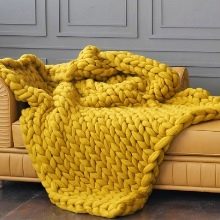

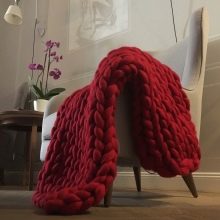
Peculiarities
A comfortable knitted accessory that serves as an adornment of any interior has recently come into fashion. The first company to launch a large knitted blanket on the market was MODERN WOOL from the USA. Merino products have become classics of the genre - weightless, extremely warm and expensive.
Knitted bedspreads instantly won the hearts of consumers. Now you can buy products:
- factory made;
- manually tied;
- smooth canvas;
- with knitted ornaments - braids, relief, squares;
- monochrome and multi-colored.
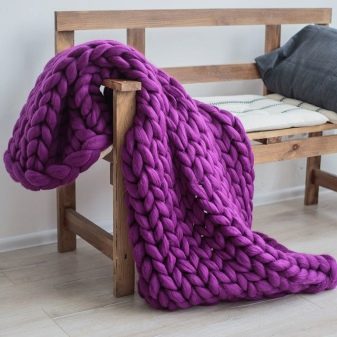
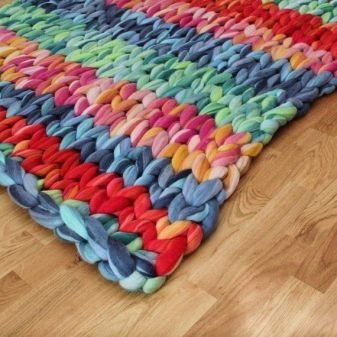
A pleasant feature of chunky knit blankets - soft knitwear - can take any shape, stretches and fills a chair, the volume of a stroller or a baby car seat. There are models with sleeves for added comfort and warmth.
Bright knitted rugs of small size serve as bedside rugs, adding charm to the interior of the bedroom or nursery. Handmade bedspreads come in a wide variety of sizes and shapes: rectangular, square, oval or round.

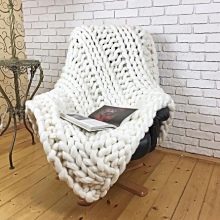
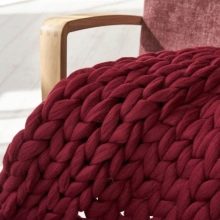
Important! Handle knitted products with care, otherwise they quickly lose their original appearance, pellets and puffs may appear.
It is not recommended to purchase expensive chunky knitwear to decorate an apartment or house where there are pets, dogs or cats. The material used to make them is delicate and delicate, even a slight contact with cat's claws can ruin your favorite thing.
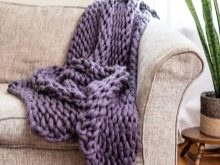
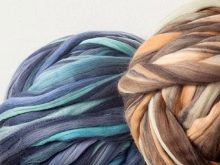
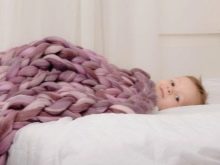
Materials (edit)
The yarn composition requirements for a factory-made or self-knitted fabric differ depending on how the product will be used. If it serves as an interior decoration and only, it can consist of one hundred percent acrylic or be mixed. If the bedspread is designed to warm and add comfort to the owner's life, it is better to use products made of natural merino wool.
There is no standard for the composition of the yarn; manufacturers use their own developments.
- Merino ribbon - merino wool is cleaned, dyed and, after combing, is slightly lying around, resulting in a voluminous and thick yarn. To reduce the cost, a small amount of sheep wool, mohair or synthetic fibers - acrylic can be added.
- Combed tape - factory-made woolen yarn, twisted from several threads to create the required volume, approximately 1.5 cm thick. Knitted products from twisted roving are slightly stiffer, less volume.
- Combed ribbon (plaid) - designed for knitted fabrics of very coarse knit, 100% wool, the texture resembles roving, without twisting.
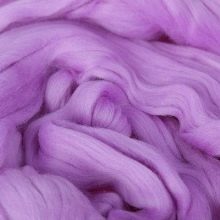
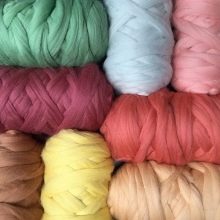
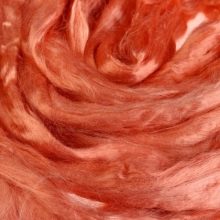
Merino wool has unique qualities that make bedspreads a desirable item:
- ease;
- dirt-repellent effect - things do not need frequent washing;
- antibacterial properties are explained by the presence of lanolin and creatine in merino wool;
- hypoallergenic;
- the ability to absorb and remove moisture well;
- lack of extraneous odors;
- mild therapeutic effect relieves pain in muscles and joints with osteochondrosis and rheumatism;
- wear resistance, ability to keep shape.


Wool is an excellent material, but the thick yarns used for chunky knits have disadvantages:
- during operation, the thread can delaminate into fibers, which complicates the process and requires caution;
- the weight of the product, especially of a large bedspread, is significant;
- high yarn price.

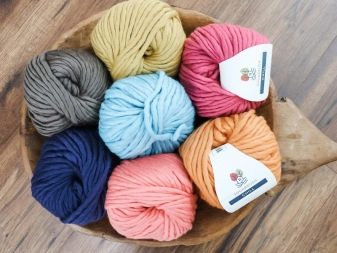
Modern hit for large knitted fabrics PUFFY yarn of the Turkish company Alize... The texture imitates fur or plush. The composition of the thread is 100% micropolyester. The blanket knitted from PUFFY is soft and pleasant to the touch. The manufacturer produces both plain and variegated threads, with different loop lengths and pile thicknesses:
- Puffy - eyelets 40 mm long, with a distance of 20 mm, in a standard skein 9.2 m;
- Puffy fine - the height of the loop is 27 mm with a distance of 15 mm, the length of the thread in a skein is 14 m;
- Puffy color - a fancy thread, sectionally dyed (the manufacturer warns that different batches have different shades of color, so you need to purchase the material with a margin).
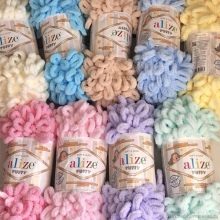
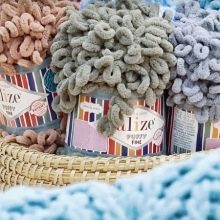
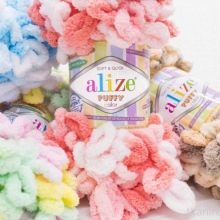
Puffy yarns are specially designed for knitting by hand, without needles or crochet hooks. A thinner version of the Puffy fine thread makes it possible to decorate the canvas with patterns without weighing the finished product.
Acrylic is often added to the yarn for the manufacture of large knitted products - a soft and light synthetic material that has found wide application in the manufacture of knitted items.
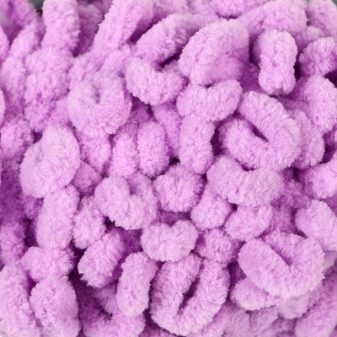
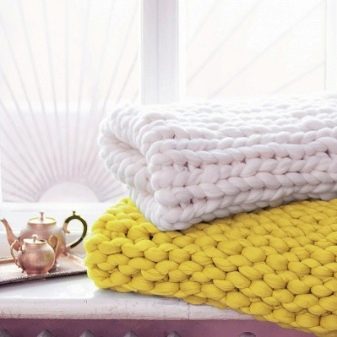
Design
The unique interior is created with carefully selected details. A large-knit bedspread is not only a fashionable accessory, it will become a bright accent on the bed in the bedroom, it will harmoniously fit into the living room, being in tune with the carpet, it can be used as a cover for an armchair or sofa.
The choice of color depends on the preferences of the buyer, as a rule, retail chains offer plain textiles. It is easy to fit knitwear in neutral natural colors into any interior. Shades such as dusty rose, coffee with milk, light gray, peach or terracotta are combined with most interiors of any style, be it country or Provence, hi-tech or strict classics.
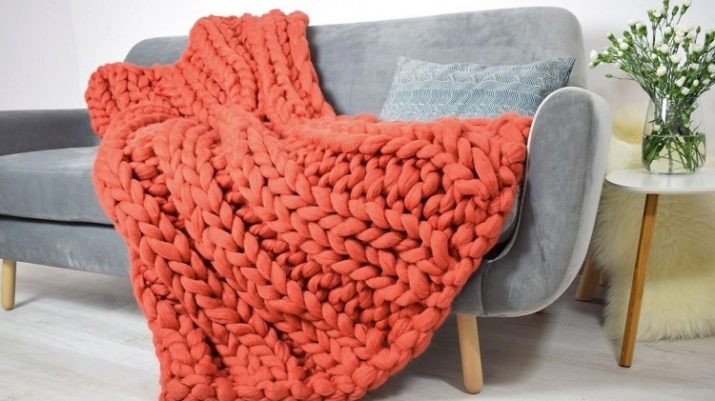
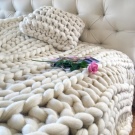
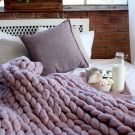
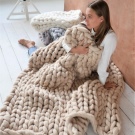
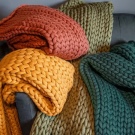
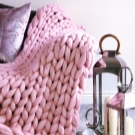
In the children's room, sand or pale blue tones of textiles are appropriate, which do not cause unnecessary emotional excitement in the baby. Modern designers use large-knit blankets in the decor of premises, solving problems:
- harmonizing the color composition as a finishing touch;
- as a way to refresh used upholstered furniture if there is no way to replace it;
- create the right emphasis on the piece of furniture or in a certain place in the room.
No matter how the newfangled accessory is used, it will surely attract the attention of guests and will not leave anyone indifferent.
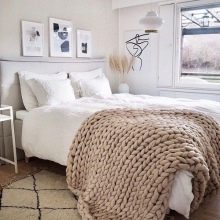

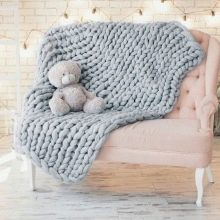
Dimensions (edit)
Standard sizes of knitted bedspreads are offered:
- XS (80x120 cm) - children's rug or blanket;
- S (100x150 cm) - for small armchairs;
- M (130x170 cm) - able to cover even modern voluminous armchairs, small sofas, will warm those who like to travel by car in cool weather;
- L (150x200 cm) - can be used as a bedspread or blanket for a single or one and a half bed;
- XL (200x220 cm) - a huge canvas on a matrimonial bed, which will not only decorate a large bed, but also warm the whole family, including pets.
Choosing the size of knitted jersey, you need to correctly assess the feasibility and purpose of the purchase. You can buy a huge knitted blanket made from natural wool and use it instead of a carpet - an original but impractical solution. In this case, it is better to give preference to mixed or acrylic fibers - such products are more practical, cheaper, easier to wash and less prone to deformation.
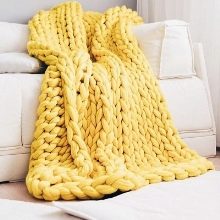
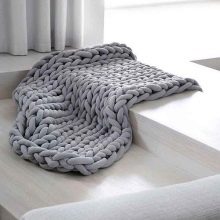
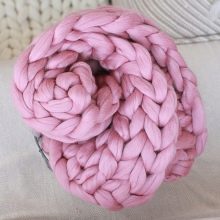
How to choose?
When purchasing a knitted item, you need to be guided by tactile sensations and your own sense of smell. A quality item does not smell of chemicals, this eliminates the likelihood of allergies. They are checked for the evenness of the edge of the textile, the density of the knit, the size and uniformity of the loops. Low density can lead to rapid deformation of the product. The composition is carefully studied for the presence of synthetic threads.
When buying on the Internet, when it is not possible to personally inspect the product, you will have to carefully study the reviews not only for the product itself, but also for the manufacturer, the material from which the coverlet was made, as well as for an Internet resource offering home textiles.
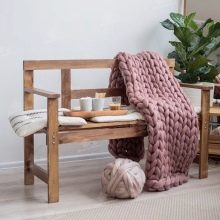
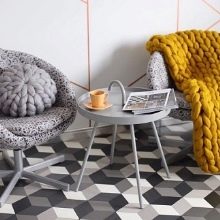
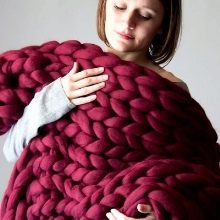
How to do it yourself?
Buying a blanket knitted of merino wool is not a cheap pleasure, especially if this product is large, its cost can reach several tens of thousands of rubles. You can get such a desirable thing by tying it yourself from threads intended for hand knitting. Such a blanket will be not only an interior decoration, but also a knitter's pride, and, on occasion, a good gift.
If you are not experienced in knitting this kind of thing, it is better to start by working on a small rug or medium-sized cape. Before starting work, you need to decide on the quantity and quality of the yarn.
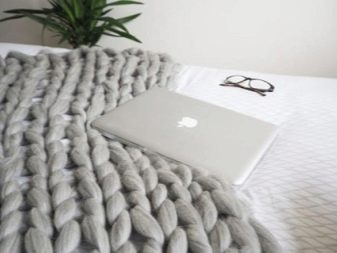
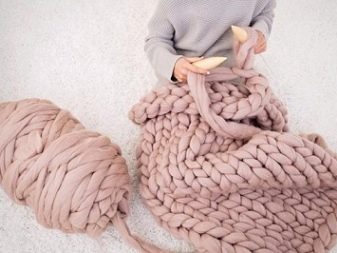
On the packaging of the yarn for hand knitting, the length and weight in grams may be indicated. The number of skeins required to knit a fabric of a certain size:
- a small baby blanket with a large knit 80x120 cm will require 2 kg of fiber;
- medium-sized bedspread 100x150 cm - 3 kg;
- a cape for a sofa, an armchair with a size of 130x170 cm - 4.5 kg;
- a blanket for a double bed measuring 150x200 cm may require up to 6 kg of yarn.
It is advisable to order yarn in large bobbins.
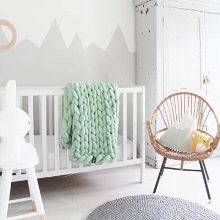
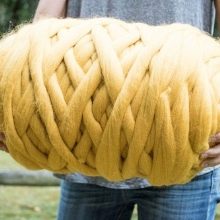
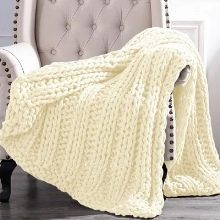
For Puffy yarn, a different calculation is relevant, since it will not work to buy it in large bobbins. When knitting with satin stitch:
- 150x100 cm - 9-10 skeins are used;
- 150x200 cm - 18-19;
- 200x200 cm - 25 packs.
The consumption of yarn when knitting a fabric with patterns increases by 1.5 times. The technique of knitting is different: on knitting needles, by hand, crochet. With the advent of the Internet in every home, you can learn a lot just by watching a training video.

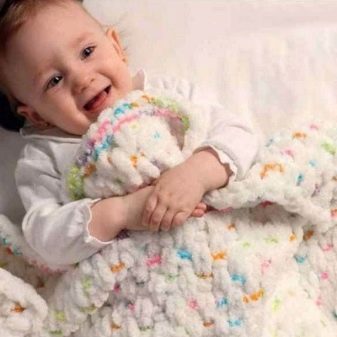
It is easier to start knitting blankets from thick threads with simple knitting methods, without using patterns. The product of ordinary garter knitting looks advantageous, with air and large loops. To form a neat braid along the edge during knitting, you need to discard, without knitting, the first loop of the row.
When knitting by hand, the loops are drawn directly onto the hands. The use of bulky yarns makes the job easier. Knitting is carried out in an unusual way - from right to left. Loops are typed on the right hand, the first row is knitted on the left. This procedure is repeated every second row.
For a thing 1 meter wide, you need to cast on 16-20 loops. For a large bedspread, you will need to cast on 30-50 loops.
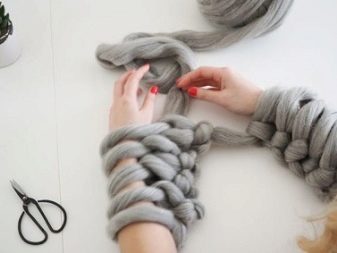

Having tied the fabric to the desired size, the loops are closed in the same way as on the knitting needles. The thread is cut and threaded into the knitted fabric. The bedspreads, interesting in their texture and color, are obtained from Puffy yarn, specially designed for knitting by hand. One of the conveniences of such threads is that it is not required to turn the bulk fabric during work, the whole product is knitted on one side. The algorithm for knitting the front surface is as follows:
- the thread of the required length is laid out on the surface of the table or floor in such a way that all the loops look in one direction;
- the thread of the second row is laid in loops towards the first;
- the loop of the upper row is threaded into the loop of the lower row and pulled out.
The loops should not be twisted, otherwise the drawing will not turn out the way it was intended. There are many patterns that can be obtained using Puffy yarn, things turn out to be soft, voluminous and cozy. Their only drawback is that fully synthetic material is not suitable for people with a tendency to allergies.
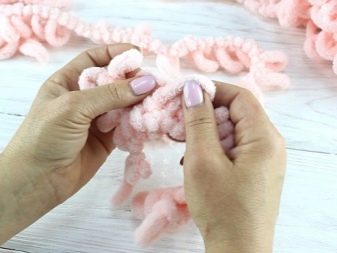
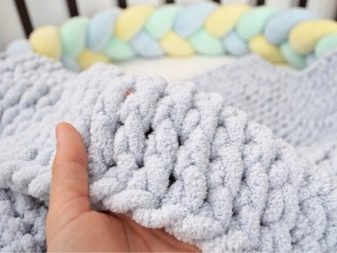
Huge knitting needles are also used for knitting, which can be ordered in online stores. Instead, you can use your own tubes with cone-shaped tips, paper twisted into a tube and wrapped for rigidity with masking tape. The knitted fabric comes out denser; to give softness and airiness, knit should be loose, without tightly tightening the loops.
Knitting from bulky yarn is good in that it takes much less time than using ordinary threads. The skill of the master affects the speed and time of knitting, on average 2-4 hours are spent on a medium-sized thing. Before knitting the next row, you need to check if there is enough thread in the started bobbin for the next one; you cannot knit the yarn in the middle of the fabric. Making home textiles with your own hands requires strength of the body and fortitude.

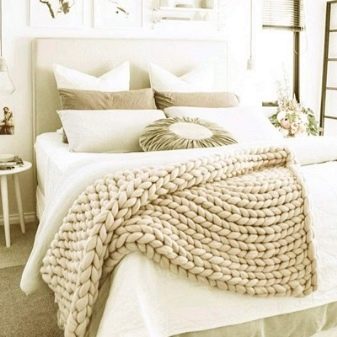
How to care?
Natural wool, especially merino wool, does not absorb dirt into the fiber, dirt remains on the surface, so it can be removed by delicate washing of the product, or using dry cleaning. Recommended to be washed by hand at 30 ° C with shampoo or a special wool care product with added lanolin. During washing, you do not need to rub the cloth, it should be wrung out gently, without twisting. It is better to dry it by spreading it out on a horizontal surface, this way you can avoid pulling the knitted product.
Washing large bedspreads is physically difficult, so it is better to use dry cleaning. It will also help with heavy dirt. Annotations for some types of merino yarns strictly prohibit washing. Only gentle cleaning is recommended using hydrocarbon, chlorine ethylene, monoflotrichloromethane. Do not store knitted bedspreads in plastic bags - wool must breathe. If long-term storage is necessary, things are packed in paper.
Beautiful, but not practical, warm, but heavy, fashionable, but short-lived, a chunky knit plaid will undoubtedly become the most original and challenging item in any interior.

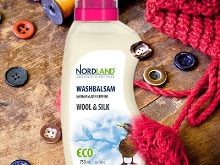
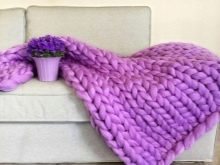
For information on how to knit a large-knit blanket with your own hands, see the next video.








